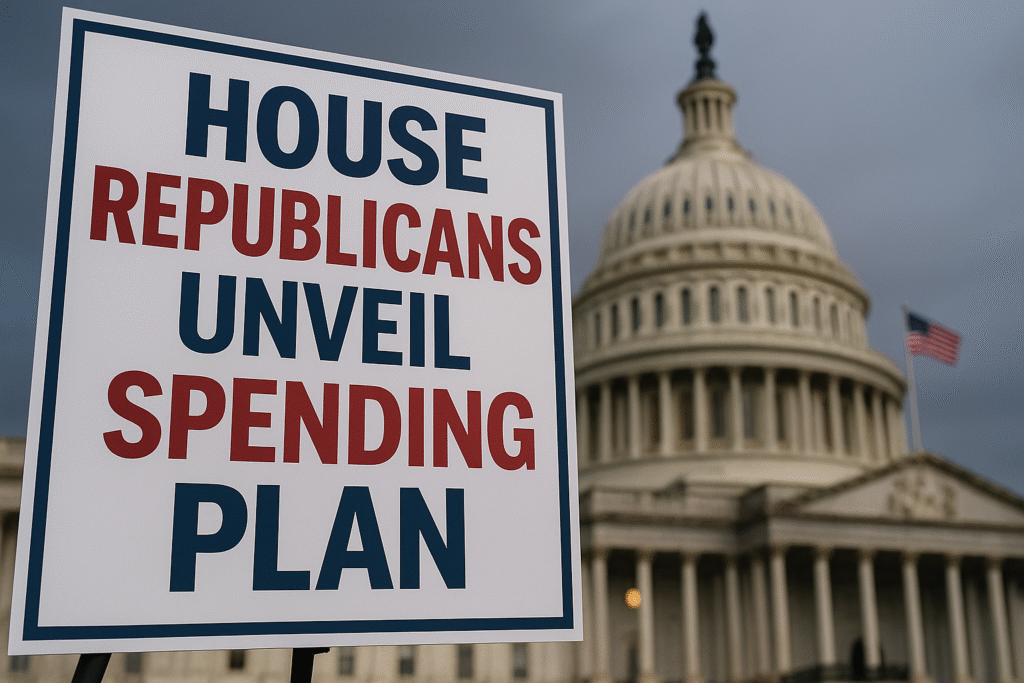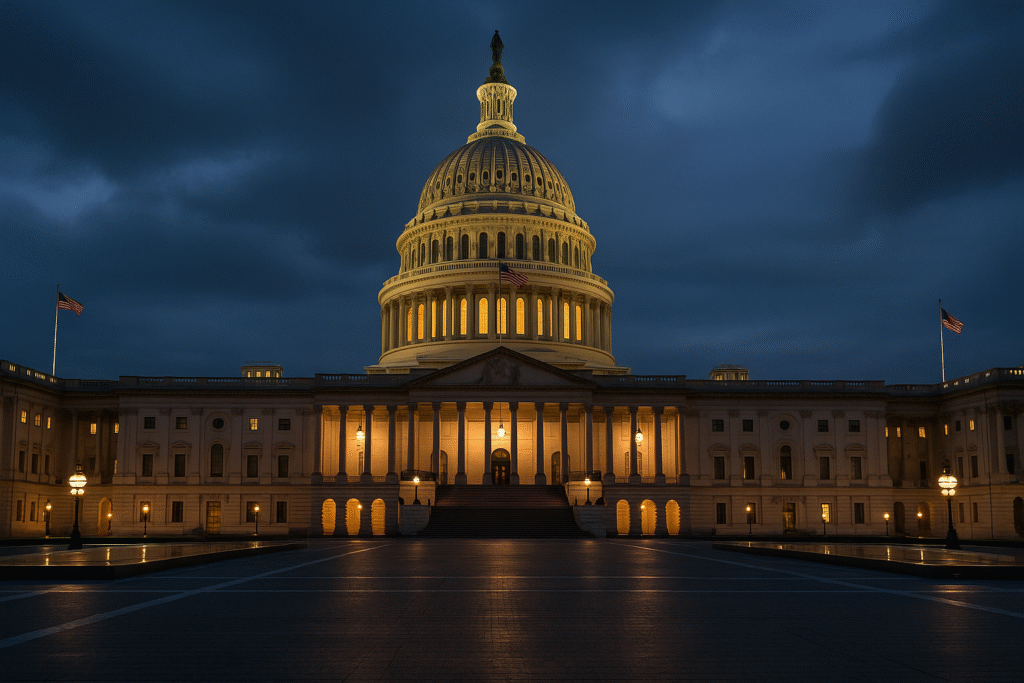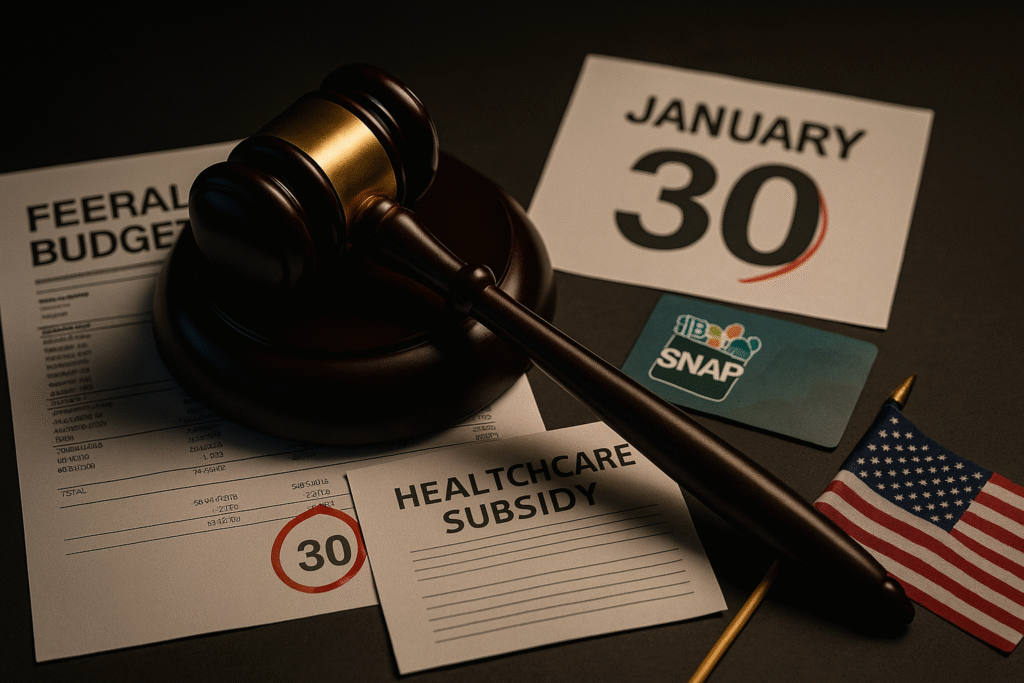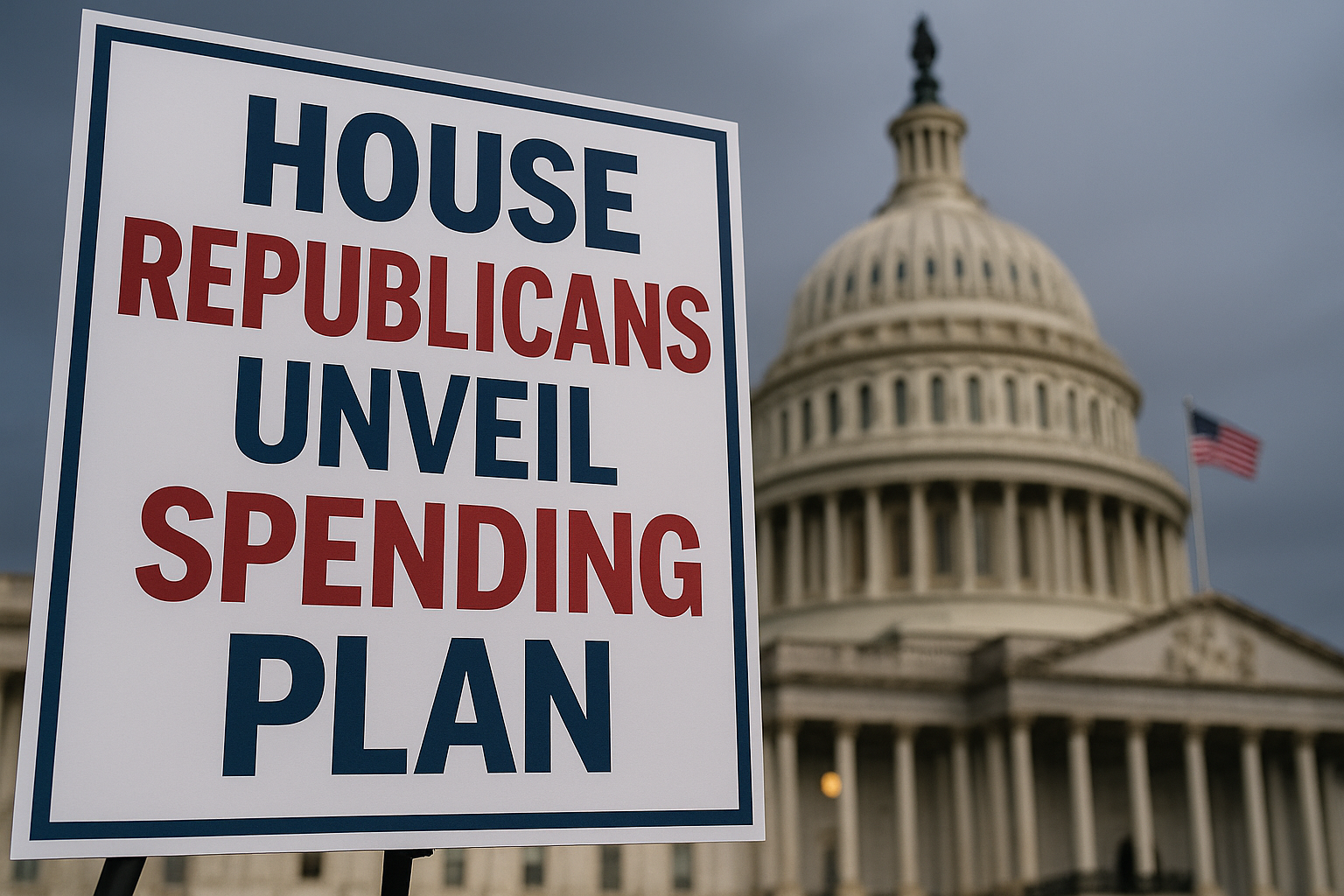US government shutdown deal advances after a weekend push in the Senate, setting up the most concrete path yet to end a record-long closure that began on October 1 and has stretched into its sixth week. In a key procedural vote late Sunday, Republicans joined with a small bloc of Democrats and one Independent to move compromise legislation forward—an agreement that would reopen the government into late January, pay back wages owed to federal employees, protect food assistance through next September, and tee up a December vote on health-care subsidies that many Democrats made their central demand. Though several hurdles remain—including House action and additional Senate steps—the vote marks the first meaningful momentum to re-start federal operations after 40 days of disruption. AP News+2The Washington Post+2
Fast Facts: The US Government Shutdown Deal at a Glance
- A bipartisan coalition cleared the first 60-vote hurdle to advance a continuing resolution (CR) that funds most agencies through January 30. AP News+1
- Eight Democrats and Independent Angus King sided with Republicans; Senator Rand Paul opposed the measure on debt grounds. The Washington Post+1
- The package pledges a December vote on Affordable Care Act (ACA) subsidies, a core Democratic ask that split the caucus. STAT+1
- Federal workers would receive back pay once final passage occurs; federal layoffs are to be reversed under the framework. The Washington Post+1
- SNAP (food aid) receives funding through next September, stabilizing benefits for tens of millions amid the shutdown’s strain. The Washington Post

Why This Step Matters Now
The Senate’s procedural vote is the inflection point that had been missing. For weeks, negotiations stalled as Democrats sought guarantees on health-care subsidies and Republicans pushed to reopen agencies first and bargain later. Crossing 60 votes signals there is a workable governing coalition—large enough to move a bill into final debate and potentially to passage. It also reframes the bargaining landscape for the House, where leaders must decide whether to mirror the Senate agreement or attempt to reshape it with amendments. If the House alters the package substantially, the measure would bounce back to the Senate, elongating the timeline. AP News
Timeline: From Lapse to Breakthrough
- October 1: Funding expires; the government shuts down. Wikipedia
- Days 1–35: Successive Senate votes fail to clear the 60-vote threshold; the shutdown becomes the longest in US history. The Guardian+1
- Days 36–40: Economic data releases are halted; airport delays and service disruptions mount; pressure intensifies on both parties. Investopedia+1
- Weekend Breakthrough: Moderate Democrats and an Independent join Republicans to advance a deal with a CR through January 30, targeted appropriations, SNAP funding, and a December vote on ACA subsidies. AP News+1
- Next: The Senate resumes debate, and the House faces its own high-stakes test—whether to pass the deal largely as written or seek changes that could re-ignite gridlock. The Washington Post
What’s Actually in the US Government Shutdown Deal
Continuing resolution through January 30: Keeps most agencies operating at current levels, immediately flipping the lights back on if enacted. The trade-off: Congress faces another hard deadline in late January, which could force a second showdown if full-year appropriations don’t materialize. The Guardian
Three full-year appropriations bills: The package contains regular appropriations for key agencies, including Veterans Affairs and Agriculture, providing stability and avoiding another round of brinkmanship for those departments. The Washington Post
December vote on ACA subsidies: Democrats who crossed the aisle did so on the strength of a promised vote next month to extend health-care tax credits that are set to lapse. Supporters say reopening the government improves the odds of passing the extension; critics counter that a scheduled vote is not the same as a guaranteed outcome. STAT+1
Back pay and reinstatements for federal workers: The framework ensures workers furloughed or working without pay are made whole after enactment and reverses recent layoffs tied to the shutdown. The Washington Post+1
SNAP funding through next September: The deal shores up the Supplemental Nutrition Assistance Program, averting deeper disruptions to a program that supports roughly one in eight Americans. The Washington Post
The Vote Math—and Why It Was So Hard
Because of the Senate’s cloture rules, most major legislation needs 60 votes to advance. Republicans hold a narrow edge in the chamber, so any movement required Democratic cooperation. Eight Democrats and Independent Angus King joined Republicans to push the bill over the line. The text does not guarantee enactment of ACA subsidy extensions, which is why many Democrats—including party leaders—voted no, arguing that the party should hold its leverage until those health-care protections are locked in. Kentucky’s Rand Paul voted no from the right, citing debt concerns. AP News+1
The Political Split Among Democrats
The US government shutdown deal has sharpened divisions within the Democratic coalition. Moderates argue that securing an up-or-down vote on subsidies—and ending the pain for federal workers and families—justifies moving forward. Party leaders and progressives, however, view the promise of a vote as too soft, fearing it gives up leverage without ensuring an outcome that keeps premiums down in 2026. That fissure will shape the December health-care debate and influence how House Democrats approach the Senate package. The Washington Post+1
How the Shutdown Is Hitting Daily Life
Air travel: Staffing strains and halted paychecks have produced cascading delays. With no end in sight until this weekend’s move, aviation officials warned of reduced capacity and persistent disruptions at major hubs. Wikipedia
Food assistance: Lapses and uncertainty around SNAP began to spill over to state planning and household budgets, with advocacy groups reporting increased demand at food banks. The Senate framework’s SNAP provision provides breathing room through next September. The Washington Post
Federal workforce: About 900,000 to 1.4 million employees were furloughed or working without pay at various points, depending on program and classification. While back pay eases the blow, missed payments and interest charges won’t vanish overnight, and contractors often don’t receive retroactive compensation. Wikipedia
Economic data blackout: The Census Bureau, Labor Department, and other agencies delayed key reports, clouding decisions for businesses, markets, and policymakers. The faster the deal finalizes, the sooner the data pipeline resumes. Investopedia

Health-Care Subsidies: December’s High-Wire Act
The most contentious policy fight is still ahead. Extending ACA subsidies controls premium spikes and out-of-pocket costs for millions. Supporters of the Senate path say reopening the government creates space to negotiate and pass a targeted bill in December; detractors say only binding subsidy language alongside the CR would sufficiently protect families facing January deadlines. Watch for two questions to dominate: What duration and generosity will the extension carry? And will any offsets or policy riders be demanded to secure 60 votes (and a House majority)? STAT+1
What Happens Next in the House
The House must still act, and that chamber has its own incentives and fault lines. Leaders can bring up the Senate approach quickly or pursue amendments that reinsert contested provisions—risking delay and a fresh round of confrontation. If the House changes the bill, the Senate would need to vote again or head to a conference, adding days to the clock. Public pressure, especially from federal workers and affected constituencies, is rising to clear a clean path to reopening. The Washington Post
Scenarios From Here
- Quick concurrence: The House passes the Senate bill with minimal changes, the Senate completes final votes, and the President signs it. Agencies reopen, back pay begins, and attention shifts to December’s subsidy vote and January’s funding deadline. AP News
- House revisions: The House adds or strips provisions, forcing the Senate to re-vote. The clock keeps ticking; federal services remain halted until both chambers align. The Washington Post
- Stall and fallback: If intra-party disputes intensify, leaders could pursue an even shorter CR or a narrower patch for urgent functions—options that risk repeating the cycle in mere weeks. The Guardian
Winners, Losers, and the Risks of Governing by Deadline
If enacted, the US government shutdown deal would immediately relieve pain for workers and families and restore operational normalcy. But governing by CR extracts costs—agency planning is squeezed, long-term hiring suffers, and key initiatives stall under last year’s spending levels. The winners in any near-term reopening are the public and frontline employees; the losers are predictability and strategic planning, which suffer when Washington lurches from deadline to deadline. The political risk is asymmetrical: whichever side is perceived as blocking reopening often pays a short-term price, while the structural forces that cause brinkmanship persist. Investopedia
How This Shutdown Became the Longest
Two dynamics made this impasse uniquely stubborn. First, each side saw core leverage in timing: Democrats insisted health-care affordability had to be guaranteed now, while Republicans argued that a promise of a vote—and immediate reopening—was the responsible route. Second, the shutdown coincided with agency calendars that magnified harm: early-quarter data releases, seasonal travel demand, and renewal windows for coverage. Those factors intensified public pressure and raised the stakes on weekend negotiations. By Day 36, it had already set a modern record; by Day 40, the combination of political exhaustion and service disruptions helped catalyze a bipartisan opening. Investopedia+1
What Agencies and Workers Should Expect If the Bill Becomes Law
- Back pay processing: Agencies historically prioritize payroll catch-up within the first cycles post-reopening, though timelines vary by department and vendor. AP News
- Program restart: Grants, inspections, and permitting will ramp back as staff return; backlogs are likely, and overtime or surge staffing may be needed. AP News
- Contractor uncertainty: Unlike federal employees, many contractors lack statutory back pay; agencies may modify contracts where possible, but outcomes differ widely. (General pattern across shutdowns.) Wikipedia
- SNAP continuity: With funding secured into next September under the framework, states should regain planning confidence and beneficiaries should see more predictable issuance schedules. The Washington Post
The January 30 Deadline: A Fuse Already Lit
Even as the Senate framework offers relief, it plants another fuse: the CR runs only through January 30. That means appropriators have mere weeks, once the government reopens, to convert this truce into durable full-year bills. Leaders will try to bank the easy wins—where bipartisan top-lines already exist—and isolate the hardest disagreements for separate negotiation. If that fails, Washington faces a familiar question at month’s end: extend again, or risk a fresh lapse. The Guardian

Key Questions We’ll Be Watching
- Will the House embrace the Senate’s path or attempt to re-write the deal? The Washington Post
- What does the December health-care bill contain—duration, subsidy levels, pay-fors, and implementation timing? STAT
- Can appropriators convert a short truce into full-year spending before the January 30 fuse burns out? The Guardian
- How quickly do agencies restore normal operations—and how large are the backlogs after six weeks? AP News
Bottom Line
The US government shutdown deal that advanced in the Senate doesn’t end the fight over health-care affordability or federal spending. But it does create a viable route to reopen the government, pay workers, stabilize food assistance, and shift the hardest policy battles to separate tracks in December and January. Whether this pragmatic sequencing is a breakthrough or merely a pause depends on what the House does next—and whether December’s subsidy vote delivers on its promise. For now, after 40 bruising days, Washington finally has a credible plan to unlock the doors. AP News+1
External Sources (for reference)
- Washington Post — Late-night Senate deal opens path to ending shutdown (published Nov. 9–10, 2025). The Washington Post
- Associated Press — Senate takes first step toward ending the government shutdown (published Nov. 9–10, 2025). AP News
- The Guardian — US government shutdown becomes the longest in history (Nov. 4–5, 2025) and Senate advances funding bill (Nov. 10, 2025). The Guardian+1
- CBS News — Day 40 live updates: eight Democrats back Senate advance (Nov. 10, 2025). CBS News
- TIME — What to know about the deal to end the shutdown (Nov. 10, 2025). TIME
- STAT — Senate takes step to end shutdown; ACA tax credit timing (Nov. 10, 2025). STAT
- Al Jazeera — Shutdown enters 40th day; Senate nears vote to end shutdown (Nov. 9–10, 2025). Al Jazeera+1
- Investopedia — Data blackout as shutdown reaches a modern record (Nov. 4–5, 2025). Investopedia
- Wikipedia overview — 2025 United States federal government shutdown (for background context and figures). Wikipedia


